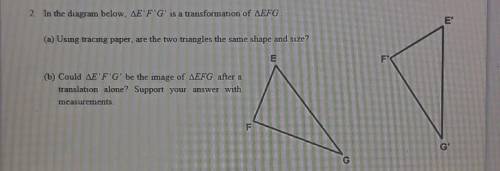In the diagram below, ∆E'F'G' is a transformation of ∆EFG.
...

Mathematics, 30.11.2020 20:50 erin93
In the diagram below, ∆E'F'G' is a transformation of ∆EFG.


Answers: 1


Other questions on the subject: Mathematics

Mathematics, 21.06.2019 14:00, pandagorwar
Emma will roll two number cubes labeled 1 through 6. she will record the sum of the two numbers after each roll. she will roll the two cubes 540 times. how many times should emma expect the sum to equal 5?
Answers: 2

Mathematics, 21.06.2019 18:50, savannahvargas512
The volume of a cone is 37x3 cubic units and its height is x units. which expression represents the radius of the cone's base, in units? 1 s o 3x o 6x obx 93x2
Answers: 1


Mathematics, 21.06.2019 23:00, kj44
Each of the following data sets has a mean of x = 10. (i) 8 9 10 11 12 (ii) 7 9 10 11 13 (iii) 7 8 10 12 13 (a) without doing any computations, order the data sets according to increasing value of standard deviations. (i), (iii), (ii) (ii), (i), (iii) (iii), (i), (ii) (iii), (ii), (i) (i), (ii), (iii) (ii), (iii), (i) (b) why do you expect the difference in standard deviations between data sets (i) and (ii) to be greater than the difference in standard deviations between data sets (ii) and (iii)? hint: consider how much the data in the respective sets differ from the mean. the data change between data sets (i) and (ii) increased the squared difference îł(x - x)2 by more than data sets (ii) and (iii). the data change between data sets (ii) and (iii) increased the squared difference îł(x - x)2 by more than data sets (i) and (ii). the data change between data sets (i) and (ii) decreased the squared difference îł(x - x)2 by more than data sets (ii) and (iii). none of the above
Answers: 2
You know the right answer?
Questions in other subjects:


Social Studies, 13.01.2021 02:30

English, 13.01.2021 02:30


Mathematics, 13.01.2021 02:30





Mathematics, 13.01.2021 02:30



